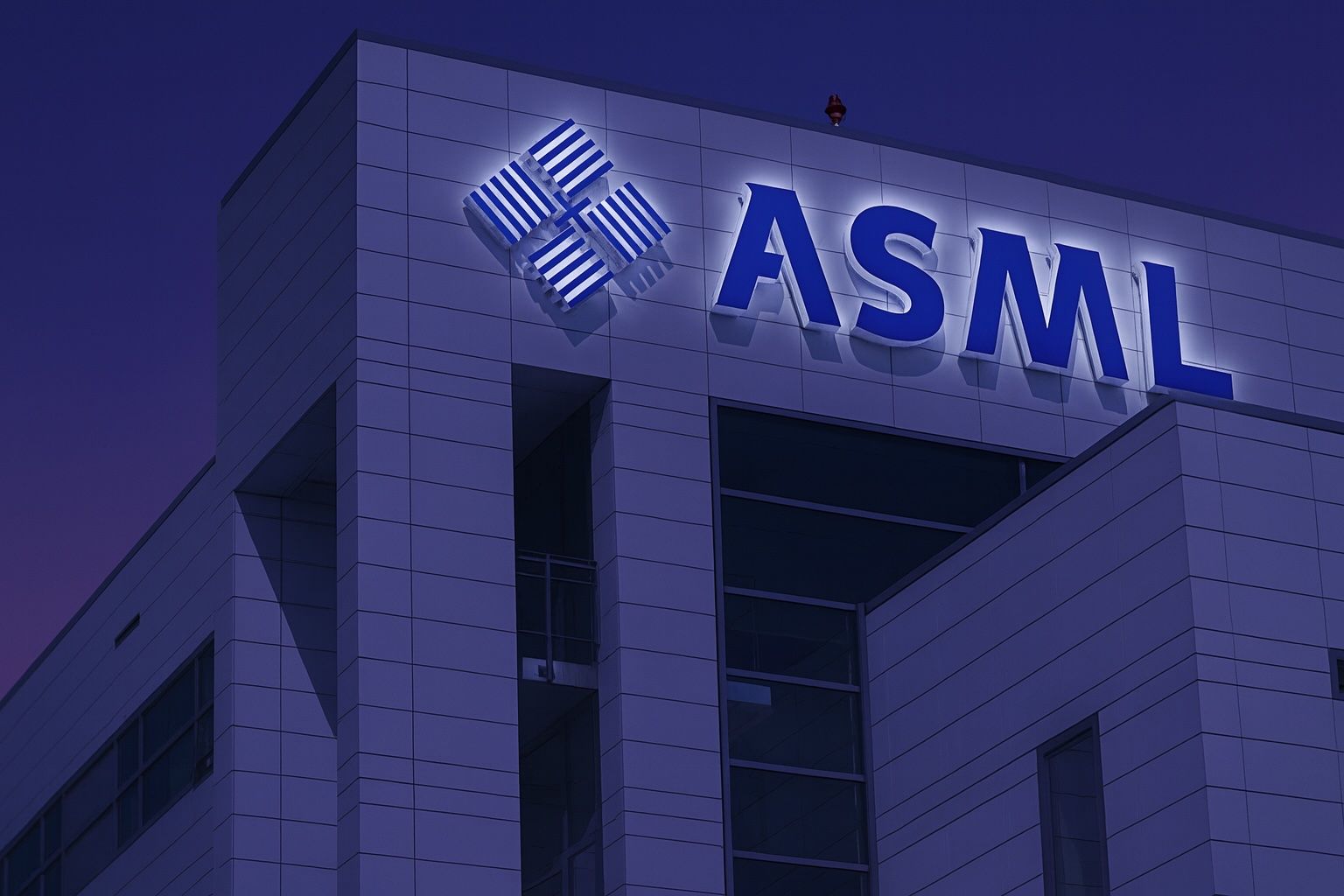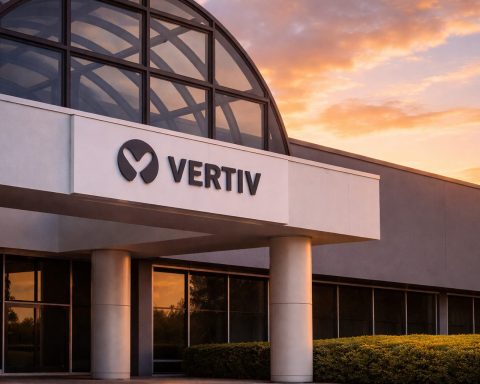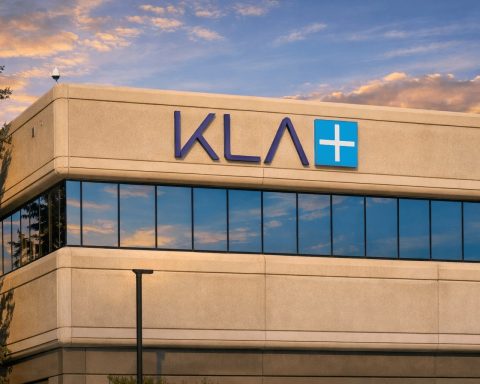- Shares Near Record Highs: ASML Holding’s stock traded around €847 on October 15, 2025 (≈$980 for its U.S. ADR), after climbing from about €813 last week [1]. The stock sits close to its 52-week peak (~€905, or $1,059) and well above key moving averages (50-day ≈$834; 200-day ≈$763) [2], reflecting strong upward momentum. Technical indicators are stretched – the RSI is above 70 (overbought) – hinting at potential short-term volatility [3].
- Q3 Earnings Beat & Cautious Guidance: ASML reported €7.5 billion in Q3 net sales and €2.12 billion net income, roughly in line with expectations [4]. New bookings of €5.40 billion slightly topped forecasts [5]. The company reiterated ~15% full-year sales growth for 2025 and issued robust Q4 guidance, but warned 2026 could see flat sales at best as China demand is set to “decline significantly” [6] [7]. One analyst noted “it could have been a stronger message” from management on the outlook [8].
- AI Partnership & R&D Moves: In a bid to capitalize on the AI boom, ASML invested €1.3 billion for an ~11% stake in French startup Mistral AI, integrating Mistral’s AI models into ASML’s chipmaking equipment [9]. CEO Christophe Fouquet called the tie-up “strategic” for enhancing customer value [10]. An ING analyst applauded the move, saying it’s “probably easier to develop AI-based products through a partnership than… in house” [11]. ASML also named 25-year company veteran Marco Pieters as its new CTO (effective 2026) to drive its technology roadmap [12].
- Geopolitics Weigh on Outlook: U.S.-China tech tensions and export controls remain a concern. ASML is barred from selling its most advanced EUV lithography machines to China under current regulations [13]. In early October, China imposed new export curbs on rare-earth metals crucial for semiconductor equipment, which “might lead to weeks-long delays” in ASML tool shipments pending export licenses [14]. A U.S. congressional report on chip gear sales to China even sent ASML’s stock down ~7% intraday on Oct. 8 [15] before it rebounded. ASML has prepared contingency plans as governments tighten trade rules [16].
- Robust Demand from Key Customers: Major chipmakers continue to drive strong demand for ASML’s machines. TSMC – ASML’s largest customer – just posted a ~30% YoY jump in Q3 revenue on booming AI chip orders [17], signaling multi-billion-dollar equipment orders ahead for ASML. Likewise, memory giants (Samsung, SK Hynix, Micron) and Intel are ramping investment in next-gen chips that rely on ASML’s EUV and upcoming High-NA EUV tools [18]. ASML’s order backlog has swelled to a record ~€33 billion [19], providing visibility well into 2026 and underscoring customers’ confidence in future chip demand.
- Analyst Sentiment – Bullish but Mindful of Risks: Wall Street remains largely positive on ASML. The stock holds a “Moderate Buy” consensus with an average 12-month target around $975–$1,000 [20]. Several analysts hiked their targets pre-earnings (e.g. JPMorgan to $1,175, Susquehanna $1,150) citing ASML’s “unique, irreplaceable” role in enabling AI chips [21]. However, its valuation (~28–30× 2025 earnings) is elevated [22]. A contrarian firm recently warned that the AI capex surge could be a “risky setup” if spending peaks [23], advising caution despite ASML’s strong long-term fundamentals.
- Strong Fundamentals and Peer Advantage: ASML dominates the lithography market with ~90% share in cutting-edge chipmaking tools [24]. In Q2 2025 it delivered €7.7 billion in sales and €2.3 billion net income (54% gross margin) [25], and it maintains a robust balance sheet (~€7 billion cash) and modest debt. The company raised its dividend by 17% in 2025 (to ~$1.85 per share, ~0.8% yield) [26] and continues share buybacks [27]. Its only real competitor in lithography, Nikon, remains a distant second focused on older tech [28]. Other chip-equipment peers like Applied Materials and Lam Research operate in different segments, making ASML’s monopoly-like position a key differentiator in the industry [29].
Stock Price & Recent Performance
ASML’s stock has been on a tear heading into mid-October. The company’s American depositary shares (NASDAQ: ASML) traded near $980 on October 15, 2025, up from around $935 a week earlier and not far from their all-time high (~$1,059) [30] [31]. In Amsterdam, ASML’s ordinary shares closed at approximately €847 on Oct. 14, continuing a rally from ~€813 at the start of last week [32]. This ~4% weekly rise outpaced the broader semiconductor index and brings ASML’s gain since early September to about +32% [33]. Year-to-date, the stock has dramatically rebounded from last year’s lows (~€580) to new highs, fueled by enthusiasm around artificial intelligence demand.
Technical Momentum: The stock’s chart shows strong bullish momentum but also hints at near-term exhaustion. ASML is trading well above its short-term averages – roughly 13% above the 50-day moving average (~$834) and 28% over the 200-day (~$763) [34]. Such extension reflects optimism but can precede a consolidation. Indeed, the Relative Strength Index (RSI) recently pushed above 70, an overbought threshold [35], and the MACD momentum indicator is strongly positive. These technicals suggest the stock may be due for a breather. If profit-taking hits, analysts see initial support around the 50-day MA near €834 (~$900) [36]. Resistance on the upside is around the early October peak (~€905, or $1,050) – a breakout above that would mark a new leg higher [37]. Volumes have been elevated on up-days, indicating institutional buying interest, yet volatility could spike around the earnings release and any macro news. Overall, the uptrend remains intact (higher highs and higher lows), so many technical traders remain in “buy the dip” mode unless the stock falls below long-term support (around $760).
Q3 Earnings: Solid Growth Amid Cautious Outlook
ASML announced its third-quarter 2025 results on October 15, and the numbers reinforced the company’s solid growth trajectory while introducing a note of caution for the future. Net sales came in at €7.516 billion for Q3, with net income of €2.125 billion [38] – essentially matching analysts’ estimates (consensus net income was €2.11 billion [39]). At ~€5.49 EPS for the quarter (basic) and over 50% gross margin, ASML’s profitability remains robust. Revenue was up about 15% year-on-year, driven by continued demand for advanced lithography systems. Notably, new orders (net bookings) totaled €5.399 billion in Q3 [40], slightly exceeding forecasts of ~€5.36 billion [41]. This order intake – a key industry barometer – indicates that despite talk of a semiconductor slowdown, big chipmakers are still planning future capacity expansions (especially for AI-related chips).
Guidance – 2025 Up, 2026 Uncertain: ASML reaffirmed its outlook for full-year 2025, projecting around +15% sales growth versus 2024 with gross margins near 52% [42] [43]. Executives pointed to a “very strong” anticipated Q4: the company guided Q4 2025 revenue between €9.2–9.8 billion [44], which implies a sequential jump as customers rush to install tools by year-end. However, management struck a notably cautious tone for 2026. In the earnings release, CEO Christophe Fouquet warned that demand from China – which was nearly one-third of ASML’s orders in the first nine months of 2025 – is expected to “decline significantly” in 2026 [45]. As a result, ASML stated that it does not expect 2026 sales to fall below 2025 levels, essentially guiding for flat or modest growth next year [46]. This is a lukewarm outlook compared to prior years of double-digit growth, reflecting uncertainties in the macro environment and export regulations.
The conservative 2026 commentary initially disappointed some market participants. “It could have been a stronger message,” said Michael Roeg, an analyst at Degroof Petercam, reacting to ASML’s tempered guidance [47]. Analysts had hoped for more confidence, given recent large AI-driven chip deals (more on those below). However, many on the Street suspect ASML is being purposely cautious and might upgrade its 2026 forecast in a January update if demand signals remain robust [48]. In fact, the company hinted that it will provide a detailed 2026 outlook at its investor day in January, leaving room to adjust expectations upward. For now, ASML is essentially telling investors that 2026 won’t be worse than 2025 – a baseline that could prove conservative if the AI chip boom continues.
Earnings Highlights: Importantly, ASML’s Q3 results underscore its resilience amid a complex environment. The firm’s net profit of €2.125 billion was in line with consensus [49], marking a slight +1.4% increase from the year-ago quarter [50]. This extends ASML’s streak – the company has beaten or met earnings expectations for eight consecutive quarters, thanks largely to relentless demand for cutting-edge chips [51]. CEO Fouquet noted that “lithography intensity” (the number of exposures per chip) continues to rise as chipmakers push the envelope on AI processors and advanced logic [52] [53]. ASML even shipped its first High-NA EUV prototype and a new advanced packaging lithography tool in Q3, highlighting progress in next-generation technology [54]. These achievements keep ASML on track technologically, even as some customers navigate cyclical slowdowns in smartphones and PCs.
In summary, Q3 showed strong current performance and a hefty backlog supporting near-term growth, but ASML tempered excitement about 2026 with a message of uncertainty. Investors will be watching early 2026 orders and January’s guidance update for clearer signals on whether this is a mere speed bump or a more prolonged plateau in growth.
AI Investments and Strategic Moves
ASML is actively aligning its strategy to the booming AI era, ensuring it not only sells the tools for AI chip production but also leverages AI within its own operations. The most headline-grabbing move was ASML’s partnership with Mistral AI, a French artificial intelligence startup. In September, ASML agreed to invest €1.3 billion in Mistral – becoming its largest shareholder with roughly an 11% stake [55] – and to embed Mistral’s AI models across ASML’s product portfolio. This deal effectively marries Europe’s foremost chip-tool maker with a cutting-edge AI software venture, a significant boost to Europe’s AI ambitions [56].
Management Commentary: CEO Christophe Fouquet hailed the Mistral partnership as a “strategic” move that will “increase the performance and productivity” of ASML’s systems for customers [57] [58]. By integrating advanced AI algorithms into lithography equipment, ASML aims to optimize how its machines operate and even improve the yield (output quality) of chips produced by its clients. Mistral’s CEO Arthur Mensch said the collaboration would “accelerate technological progress across the global semiconductor and AI value chain,” underscoring the symbiotic potential of the tie-up [59]. For ASML, which historically focuses on hardware, this kind of software-centric investment is somewhat unusual – highlighting how critical AI has become in the semiconductor realm.
Analyst Reaction: The investment drew positive feedback from industry experts. Jan Frederik Slijkerman, an analyst at ING, noted that ASML likely found it “easier to develop AI-based products through a partnership than to do this in-house.” [60] In other words, rather than starting from scratch on AI, ASML bought into an existing innovator – a faster route to gain AI expertise. Analysts view this as a smart strategic move to keep ASML’s competitive edge sharp: embedding AI could help its tools run more efficiently, catch defects, and enhance chip manufacturing processes, all of which make ASML’s products more indispensable to customers.
Beyond the Mistral deal, ASML has also been tending to its leadership and R&D talent. On Oct. 9, the company announced it will appoint Marco Pieters as Chief Technology Officer (CTO) in April 2026 [61]. Pieters is a 25-year ASML veteran who has led development of some of the company’s most advanced systems. Elevating him to CTO (succeeding retiring CTO Martin van den Brink) signals continuity in ASML’s technology roadmap. CEO Fouquet emphasized that “technology lies at the heart of ASML” and voiced confidence that Pieters will drive the innovation pipeline forward [62]. This leadership transition comes as ASML is working on its next big product – the High-NA EUV lithography machine – expected to enable even smaller chip features later this decade. The CTO choice assures customers that ASML’s deep bench of engineering talent remains focused on pushing the boundaries of chipmaking.
In sum, ASML’s recent strategic initiatives – investing in AI, forging partnerships, and reinforcing its tech leadership – show a company preparing for the future. By fusing AI into its core products and keeping experienced hands on the R&D tiller, ASML aims to extend its dominance in an industry at the nexus of AI and advanced manufacturing.
Geopolitical & Supply Chain Challenges
While technological and market forces propel ASML forward, geopolitical currents are presenting challenges that investors can’t ignore. As a critical player in the global semiconductor supply chain, ASML often finds itself caught in the crossfire of U.S.-China tech tensions and international trade policies.
Export Controls on China: One of the most significant constraints on ASML’s growth is the restriction on selling its most advanced machines to Chinese customers. ASML is barred by Dutch and U.S. export regulations from shipping its cutting-edge EUV lithography systems to China [63]. These ~$200 million apiece EUV tools are essential for making the latest generation of chips, and China’s inability to acquire them has effectively capped ASML’s sales into that market at older technology levels (like DUV immersion tools, which require special export licenses). As a result, China – which had been a major source of growth for chip equipment – may contribute less to ASML’s revenue going forward. In fact, through 2025, Chinese chipmakers placed many orders for older ASML systems, but those could drop off sharply next year. Fouquet explicitly warned that “China total net sales in 2026 [are set] to decline significantly” compared to the high levels of 2024-25 [64].
Rare-Earth Restrictions: In a tit-for-tat dynamic, China has leveraged its own strategic chokehold: rare-earth minerals. In October, Beijing imposed new export controls on gallium and germanium (metals critical for semiconductor manufacturing and high-tech optics). According to Bloomberg reports, this “might lead to weeks-long delays in shipments for ASML” because even small amounts of Chinese-sourced components in ASML’s tools could require special export approvals [65]. ASML uses high-precision components (like lasers, optics, and magnets) that sometimes contain rare-earth elements. The new Chinese rules mean if ASML or its suppliers need to send any such components from China (or re-export them through China), they must navigate a licensing regime that could slow down deliveries [66]. ASML has acknowledged it is “preparing for disruptions” under these rules [67] and reportedly has contingency plans to source materials elsewhere or redesign products if needed [68]. While the long-term impact is unclear, this development injected fresh uncertainty into ASML’s supply chain in Q4 2025.
Market Jitters from Geopolitics: Investors have reacted sharply to these geopolitical headlines. On October 8, ASML’s stock plunged over 7% intraday after a U.S. House of Representatives committee released a report suggesting that Western semiconductor equipment might be aiding China’s military chip development [69]. The report singled out companies like ASML (and its U.S. peers) in scrutinizing past sales to China. Although ASML’s shares recovered once clarifications emerged (and given that ASML complies with export laws), the episode underscored how sensitive the stock is to geopolitical risk. Similarly, when China announced its rare-earth export curbs earlier in the month, ASML’s stock saw a quick pullback amid fears of supply snags [70]. It’s a reminder that policy moves in Washington, Beijing, or Brussels can swing market sentiment on ASML in the short run.
Strategic Asset: On the flip side, ASML’s geopolitical importance can also be a strength. The company is now seen as a strategic asset by Western governments – effectively, a crown jewel of the European tech industry and a linchpin in the U.S.-led effort to constrain China’s advanced chip capabilities. This means ASML often enjoys governmental support (the Dutch government, under U.S. pressure, tightly controls ASML’s China exports) and could benefit from policies encouraging chipmaking in Europe and America. For instance, U.S. and EU “Chip Act” initiatives, which fund new semiconductor fabs domestically, indirectly boost demand for ASML’s equipment (with local fabs like Intel’s new projects likely buying more ASML machines). However, the company must carefully balance appeasing its home regulators with not alienating a potential future market in China if relations thaw.
In summary, geopolitical and supply chain issues pose a moderate risk to ASML’s otherwise bright outlook. Export bans mean some lost sales and a need to find new buyers for high-end tools (fortunately, Taiwan, Korea, and the U.S. are absorbing many of them). Materials curbs introduce supply uncertainty that ASML will work to engineer around. Investors should expect periodic bouts of volatility in ASML’s share price as news breaks on the U.S.-China tech front. Over the long run, however, ASML’s central role in chipmaking may also ensure it remains protected and valued by the West in the unfolding “chip war.”
Customer Demand and Industry Trends
A key pillar of ASML’s investment case is strong, ongoing demand from its major customers – the world’s leading semiconductor manufacturers. Despite pockets of weakness in consumer electronics, the surge in AI, data center, and high-performance computing is driving big orders for cutting-edge chips, which in turn drives orders for ASML’s cutting-edge machines.
TSMC, Samsung, Intel: AI Boom Benefits – Taiwan’s TSMC, the largest contract chipmaker and a top client of ASML, illustrates the trend. In early October, TSMC reported that its third-quarter revenue jumped ~30% year-on-year, far exceeding expectations, thanks largely to booming orders for AI chips used in data centers [71]. (TSMC fabricates chips for companies like NVIDIA, whose AI GPUs are in ferocious demand.) To fulfill those orders, TSMC has to aggressively invest in new production capacity – including the latest EUV lithography systems from ASML. In fact, industry observers note that a substantial portion of ASML’s record order backlog comes from TSMC’s needs for its 3nm and future 2nm fabs. Likewise, Samsung and Intel – both racing to develop next-generation process technologies – rely heavily on ASML. Samsung is using EUV tools for its most advanced DRAM memory and logic chips, and has plans for High-NA EUV when available. Intel, for its part, has bet on EUV for its upcoming 18A process node and beyond. ASML’s CEO highlighted that customers’ “investments in AI” are extending to more fabs and products across both leading-edge logic (processors) and advanced memory (like high-bandwidth RAM for AI) [72]. In short, the AI gold rush is feeding directly into ASML’s order book.
Record Backlog: The clearest evidence of this robust demand is ASML’s order backlog, which now stands at approximately €33 billion (as of Q3 2025) [73]. This is an all-time high and represents roughly a year’s worth of revenue for ASML. Because ASML’s tools can take 12–18 months to build and deliver, customers must order far in advance. A €33B backlog means ASML already has a deep pipeline of shipments into 2026 and even 2027. Analysts at Trefis note this huge backlog “bodes well for future revenue growth” and reflects strong customer confidence in ASML’s technology and their own future chip demand [74]. Notably, ASML’s backlog includes orders across its product lines – from the flagship EUV scanners (where demand is highest) to DUV systems and newer specialty tools. The company has indicated it will increase capacity in coming years to shorten lead times, but for now the backlog essentially locks in a baseline of sales even if the macro environment softens temporarily.
Broader Industry Cycle: It’s worth noting that the semiconductor industry operates in cycles, and ASML is not immune to the ebbs and flows. 2023 saw a downturn in smartphone and PC-related chip demand, which led some chipmakers to scale back equipment orders. ASML’s own order intake in the first half of 2025, at €9.5B, was slightly down from the prior year [75], reflecting that lull. However, the second half of 2025 has seen a sharp rebound driven by the new AI-related spending cycle. Additionally, “megadeals” in the chip world – such as massive long-term supply agreements between chip designers and cloud companies – are giving chip manufacturers the confidence to invest in expensive new fabs. Recent multi-billion-dollar deals (e.g. Meta and Oracle pre-paying for chips from NVIDIA, AMD, etc.) effectively guarantee future demand for advanced chips [76], which requires ASML equipment to produce. As Reuters summarized, these AI-fueled deals have “boosted hopes for chipmaking equipment demand” across the industry [77].
Looking ahead, areas like automotive chips and Internet-of-Things (IoT) devices are also expected to pick up, providing more avenues of growth for chip equipment. ASML’s tools are used not just for the absolute cutting-edge chips but also in high-volume production of slightly older nodes. So as global chip demand broadens (with more chips in cars, appliances, etc.), ASML’s total available market should expand. The main caveat is timing – if macroeconomic conditions (inflation, consumer spending, etc.) cause a broader pullback in tech spending, chipmakers might delay some of their expansion plans in 2026. ASML’s own stance is that 2025 will be strong and 2026 should be at least flat; the company is not ready to predict an upcycle or downcycle yet for 2026 [78]. It all depends on how the opposing forces play out: AI and data-center growth versus potential weakness in other electronics and the impact of rising interest rates on tech investment. So far, the scales are tipped in favor of growth, as evidenced by ASML’s order book and customers’ commentary.
Analyst Views and Stock Forecasts
Wall Street’s Take: Despite near-term uncertainties, most market experts remain bullish on ASML given its unique franchise. According to data from TipRanks and other aggregators, the consensus rating on ASML is a “Moderate Buy” to “Buy”, with over 80% of covering analysts rating it positively and few, if any, outright Sell ratings [79]. The average 12-month price target sits around $976 per share [80], roughly 8–10% above the current trading level – suggesting analysts expect continued upside. Many firms updated their models ahead of the Q3 earnings: notably, JPMorgan raised its target from $957 to $1,175, Susquehanna hiked to $1,150, and Wells Fargo to $1,105 [81]. These bullish revisions were based on expectations of a “robust beat-and-raise” quarter fueled by strong EUV demand [82] (which largely materialized in Q3) and optimism that AI-driven orders will keep momentum going into 2024.
Analysts frequently emphasize ASML’s unparalleled competitive position. As Morningstar’s Javier Correonero observed, “sentiment has changed” positively in recent months, and ASML’s management needs to give clarity on how they see the market evolving post-AI boom [83]. The consensus is that ASML holds a “generational” opportunity – essentially a near-monopoly on critical technology – and thus deserves a premium valuation [84]. In research notes, phrases like “unique, irreplaceable position” and “monopolistic hold on EUV” are common descriptors of ASML [85]. This reflects the view that as long as the world needs faster, smaller, more efficient chips, ASML will be selling the proverbial “picks and shovels” to all the major semiconductor “gold miners.”
Valuation Concerns: However, analysts are not oblivious to risks. A few are urging caution primarily on valuation and cycle timing. After the recent rally, ASML’s stock trades around 28–30 times projected 2025 earnings [86] – a rich multiple for a capital equipment manufacturer. This P/E reflects high expectations for continued growth. If any hiccup (like a push-out of orders or a margin squeeze) occurs, the stock could de-rate. New Street Research recently downgraded ASML to a Hold, setting a target around $918 [87]. New Street’s analyst Pierre Ferragu argued that the current AI spending surge might be front-loading a lot of demand – a “risky setup” if it means orders peak and then decline in coming years [88]. In his view, ASML’s excellent long-term story was fully priced in above $900, and he advised waiting for a better entry point in case of a cyclical pullback.
Similarly, some market commentators on CNBC have pointed out that macro factors (rising interest rates, potential recession) could cool off capital investment by chip companies, which would hit equipment suppliers like ASML. They caution that investors buying at the top of the cycle could experience volatility if 2026 turns into a down year for capex. Moreover, ASML’s ~$375–380 billion market capitalization [89] means it’s one of the world’s most valuable tech companies; sustaining that requires consistent execution.
Long-Term Confidence: Nonetheless, virtually all analysts acknowledge ASML’s long-term fundamentals remain extremely strong. The company’s balance sheet is healthy (net cash position, ongoing buybacks, and dividends) and its technology moat is wide. Even firms with short-term caution often frame ASML as a core long-term holding. For example, a TS2.Tech analyst noted that even if there’s near-term risk, ASML’s dominant position makes it a “must-own” for exposure to the future of AI and computing [90]. The consensus expectation is that ASML can grow earnings into its valuation over time, especially if it maintains ~15% annual revenue growth and expands service revenues (which are recurring as the installed base grows).
In terms of stock forecasts: for short-term traders, much will hinge on news flow – a solid next earnings report or positive guidance revision could quickly propel ASML above $1,000, while any hiccup might send it temporarily back into the $800s. For long-term investors, many analysts suggest using any significant dips as buying opportunities, given that ASML’s technology will likely be at the heart of chip advancements for the next decade.
ASML’s Competitive Landscape and Peers
ASML occupies a singular position in the semiconductor equipment industry, which largely insulates it from direct competition but also means comparisons to “peers” require context. In the specific domain of lithography tools – the machines that print microscopic circuits on silicon – ASML is the undisputed leader globally. In fact, it holds roughly 90% market share in advanced lithography (immersion DUV and EUV combined) [91]. It has virtually a 100% share in EUV lithography, since no other company currently produces viable EUV systems for high-volume manufacturing. This dominance is the result of decades of R&D and a complex supply chain that ASML has mastered (including partnerships with Zeiss for optics, etc.). ASML’s only historic rival in lithography, Japan’s Nikon, has been relegated mostly to older-generation tools. Nikon still competes in deep-ultraviolet (DUV) lithography to an extent, but even there ASML holds ~90% of the immersion DUV market [92]. Nikon is reportedly developing a next-gen immersion scanner aiming for 2027, but for now it remains a distant second and has essentially zero presence in EUV [93].
Because of this, when one talks about ASML’s “peers,” it usually refers to other semiconductor equipment companies that serve different steps in the chip fabrication process. The top names are Applied Materials (AMAT), Lam Research (LRCX), KLA Corporation (KLAC), Tokyo Electron, among others. These firms make tools for processes like etching (carving out patterns), deposition (layering materials on a wafer), and inspection/metrology (measuring and defect checking). ASML does not directly compete in those areas [94] – in fact, it sometimes partners with those companies to deliver integrated solutions to customers. For example, after ASML’s earnings, if a new export restriction hits China, stocks of Applied Materials and Lam often move in tandem with ASML because investors see them as part of the same supply chain exposed to China [95]. But on a product basis, ASML’s lithography franchise stands apart.
Implications of ASML’s Moat: ASML’s near-monopoly in a critical technology grants it significant pricing power and profit margins that many peers envy. It also creates high barriers to entry – any aspiring competitor would need to replicate ASML’s enormous R&D investment, ecosystem partnerships, and expertise accumulated over decades. This is why even tech giants in China, despite enormous funds, have not been able to create an EUV machine; ASML’s head start is too great. The company’s dominance is often compared to an “Intel inside”-like position for manufacturing: if you want to make cutting-edge chips, you essentially must “partner” with ASML (by buying its machines). This status has led some to call ASML “the most important tech company you’ve never heard of” in mainstream media, highlighting that behind every advanced chip is ASML’s technology.
Peer Performance: In 2025, ASML’s stock performance has outshone many of its industry peers, thanks to its direct leverage to AI. For instance, the Philadelphia Semiconductor Equipment Index is up strongly, but ASML’s +30% move (since September) beat the broader group’s ~15% rise in that period [96]. Applied Materials and Lam Research have also risen (driven by memory chip equipment recovery and AI data center investments), but neither has the pure-play exposure to leading-edge logic like ASML does. On valuation, ASML’s ~28x forward earnings multiple is higher than AMAT or LRCX (which might trade around 18–20x), reflecting ASML’s superior growth and monopoly status. This “premium position” is baked into the stock price [97], as analysts note. It means ASML has less room for error – its execution needs to stay top-notch to justify the premium, whereas a company like Applied Materials (with more competition) trades at a discount but also might be considered in a different risk category.
In summary, ASML has no true like-for-like competitor in its main business, an enviable situation that contributes to its hefty margins and market cap. Investors comparing ASML to peers should consider that it operates more as a specialized monopoly supplier, whereas others are in more competitive sub-segments of the market. The flipside is that ASML’s fortunes are closely tied to the overall health of the semiconductor capital expenditure cycle. When chipmakers pull back on fab spending, all equipment firms (ASML included) feel the pinch, even if ASML tends to hold up better due to its backlog. When a geopolitical shock hits (like an export ban on China), ASML and peers often see a correlated sell-off [98]. But over a full cycle, ASML’s unique role tends to allow it to outgrow and outperform the rest of the industry.
Outlook: Short-Term Catalysts vs. Long-Term Trajectory
Near-Term (Weeks to Months): In the immediate future, ASML’s stock will likely be driven by the cadence of news and results. The Q3 earnings are now in the books; investor focus shifts to whether ASML can beat its Q4 guidance and if management might upwardly revise 2026 expectations at January’s update. Any hints of improving order trends (e.g. if orders from memory chipmakers pick up or if Chinese logic firms find a way to buy more DUV tools) could cheer the market. Conversely, signs of order push-outs or cautious customer commentary could spur a pullback. Market sentiment overall – such as shifts in interest rate outlook or global market volatility – will also influence ASML, given it’s a large-cap tech name. Technically, traders are watching if ASML can decisively clear the ~$1,050 resistance from its recent high or if it will consolidate in the $900s. A breakout on strong volume could signal another leg higher, whereas a break below the 50-day moving average (around $910/€840) might invite short-term sellers [99]. Many expect the stock to remain range-bound to upward biased into year-end, barring any negative shock.
Medium-Term (6–12 months): Over the next year, the key question is how the AI investment cycle balances against potential headwinds. If the surge in AI/data center chip demand continues (with cloud giants and others pouring money into new chips), ASML should see sustained order inflows – especially for its EUV and forthcoming High-NA EUV tools that enable next-gen chips. This scenario would likely lead to continued revenue and earnings growth in 2026, and analysts’ models would tick higher. There are, however, realistic risks to watch: a broader economic slowdown could cause even AI-related spending to moderate, or chip customers might digest their 2025 equipment purchases and slow ordering in 2026. ASML itself has guided cautiously, effectively planning for ~0% to modest growth in 2026 [100]. If by mid-2026 it becomes clear that growth will reaccelerate (say, via a wave of new fab projects or better macro conditions), ASML’s stock could rerate higher. On the flip side, if 2026 shapes up to be an air-pocket year (flat revenues or down slightly), the stock might trade more sideways as investors wait for the next upturn. That said, with an €33B backlog insulating it, ASML is better positioned than most to weather a soft patch. Even in a scenario where orders temporarily dip, the company would be busy delivering on its huge backlog, keeping revenues relatively steady.
Long-Term (Multi-year): The long-range outlook for ASML remains fundamentally bullish. Over a 5–10 year horizon, secular trends strongly favor the company. Virtually every cutting-edge chip made in the world for the foreseeable future will use ASML’s equipment in some part of its process. As semiconductor technology advances to 3nm, 2nm, and eventually beyond into angstrom-class scales, lithography (and especially EUV) becomes even more critical. ASML is on track to introduce High-NA EUV (a next-generation platform with even finer resolution) around 2025–2026, which early customers (like Intel, TSMC, and imec) are already testing. If successful, High-NA EUV will extend Moore’s Law further and keep ASML at the technological forefront. Additionally, new paradigms like chiplet architectures, 3D integrated circuits, and advanced packaging – while different from traditional scaling – still rely on lithography for making interconnects and hybrid bonds. ASML is already shipping specialized tools (e.g. the TWINSCAN XT:2600 for packaging [101]) to tap into these emerging needs.
On the demand side, the world’s appetite for computing power shows no sign of abating. Artificial intelligence, 5G, IoT, autonomous vehicles, cloud computing – all these trends require vast numbers of advanced chips. Nations and regions are also investing heavily in domestic semiconductor capacity for security and economic reasons (witness fabs being built in the U.S., Europe, India, etc.). These initiatives effectively mandate purchases of ASML machines. As one analyst put it, ASML’s customers “must buy its machines” to stay at the leading edge [102] – a great position for any company to be in. Over the next decade, ASML’s challenge will be to execute: scaling up production to meet demand, continuing to innovate its tools (the company spends over €3 billion on R&D annually), and navigating geopolitical twists. If it meets those challenges, ASML could plausibly continue compounding its revenue and profit at a healthy clip for years, rewarding patient investors.
Investor Bottom Line: ASML Holding has ridden the wave of the semiconductor industry’s latest boom, emerging as one of the big winners of the AI revolution in chips. The stock’s strong run in 2023–2025 reflects high expectations, and investors should be mindful of potential speed bumps (from China, cyclicality, or even a broader market downturn). The upcoming quarters will test whether AI demand can carry the torch until other end-markets recover. However, given ASML’s unrivaled market position, technological moat, and hefty backlog, many analysts see any interim dips as opportunities. For those with a long-term horizon, ASML represents a unique cornerstone of the semiconductor value chain – a company with substantial pricing power and a virtually essential role in enabling the future of electronics. In the words of one market strategist, “ASML is not just riding the industry’s growth; it’s enabling it.” As long as that holds true, the company’s prospects – and by extension, its shareholders – stand on solid ground.
Sources: ASML Press Release (Q3 2025) [103] [104]; Reuters [105] [106] [107]; TS2.tech [108] [109] [110] [111]; Taipei Times [112]; Mitrade [113]; Bloomberg via Taipei Times [114]; ASML Investor Call and SEC filings; MarketBeat/StockAnalysis data [115] [116].
References
1. ts2.tech, 2. ts2.tech, 3. ts2.tech, 4. www.reuters.com, 5. www.reuters.com, 6. www.reuters.com, 7. www.reuters.com, 8. www.reuters.com, 9. ts2.tech, 10. ts2.tech, 11. www.reuters.com, 12. ts2.tech, 13. ts2.tech, 14. ts2.tech, 15. ts2.tech, 16. ts2.tech, 17. ts2.tech, 18. ts2.tech, 19. ts2.tech, 20. ts2.tech, 21. ts2.tech, 22. ts2.tech, 23. ts2.tech, 24. ts2.tech, 25. ts2.tech, 26. ts2.tech, 27. ts2.tech, 28. ts2.tech, 29. ts2.tech, 30. ts2.tech, 31. ts2.tech, 32. ts2.tech, 33. www.reuters.com, 34. ts2.tech, 35. ts2.tech, 36. ts2.tech, 37. ts2.tech, 38. www.reuters.com, 39. www.reuters.com, 40. www.asml.com, 41. www.reuters.com, 42. www.asml.com, 43. www.asml.com, 44. www.asml.com, 45. www.reuters.com, 46. www.reuters.com, 47. www.reuters.com, 48. www.reuters.com, 49. www.reuters.com, 50. www.reuters.com, 51. ts2.tech, 52. www.asml.com, 53. www.asml.com, 54. www.asml.com, 55. ts2.tech, 56. www.reuters.com, 57. ts2.tech, 58. www.asml.com, 59. ts2.tech, 60. www.reuters.com, 61. ts2.tech, 62. ts2.tech, 63. ts2.tech, 64. www.asml.com, 65. ts2.tech, 66. ts2.tech, 67. ts2.tech, 68. ts2.tech, 69. ts2.tech, 70. ts2.tech, 71. ts2.tech, 72. www.asml.com, 73. ts2.tech, 74. ts2.tech, 75. www.reuters.com, 76. www.reuters.com, 77. www.reuters.com, 78. www.asml.com, 79. ts2.tech, 80. ts2.tech, 81. ts2.tech, 82. ts2.tech, 83. www.reuters.com, 84. ts2.tech, 85. ts2.tech, 86. ts2.tech, 87. ts2.tech, 88. ts2.tech, 89. ts2.tech, 90. ts2.tech, 91. ts2.tech, 92. ts2.tech, 93. ts2.tech, 94. ts2.tech, 95. ts2.tech, 96. www.reuters.com, 97. ts2.tech, 98. ts2.tech, 99. ts2.tech, 100. www.reuters.com, 101. www.asml.com, 102. ts2.tech, 103. www.asml.com, 104. www.asml.com, 105. www.reuters.com, 106. www.reuters.com, 107. www.reuters.com, 108. ts2.tech, 109. ts2.tech, 110. ts2.tech, 111. ts2.tech, 112. ts2.tech, 113. ts2.tech, 114. ts2.tech, 115. ts2.tech, 116. ts2.tech







